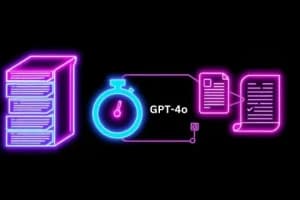We need to convert images into tensors before we can use them with deep learning. Thankfully, PyTorch will do the groundwork for us. Tensors are PyTorch data storage and multi-dimensional arrays. They assist in feeding images into neural networks for training and inference. In this article, we will see how we can convert images to tensors using PyTorch. We will discuss common challenges we face in conversion from images to tensors and the best practices we can follow. Let's dive into it!
Table of Contents:
1. Why Convert Images to Tensors?
2. Using PyTorch's Transforms Module
- Method 1: Using transforms.ToTensor()
- Method 2: Using torch.from_numpy()
- Method 3: Using torchvision.io.read_image()
3. Converting Images Using PIL and OpenCV
- Using PIL
- Using OpenCV
4. Batch Processing: Folder of Images
- Converting a Folder of Images to Tensors
5. Common Challenges and Best Practices
- Handling Image Size Inconsistencies
- Working with Grayscale Images
- Memory Management for Large Datasets
6. Understanding the Shape of Image Tensors
7. FAQs
8. Conclusion
1. Why Convert Images to Tensors?
Converting images to tensors is very crucial for neural networks as it helps in efficient mathematical computations, plays nicely with GPUs, and represents the dimensionality of images correctly. We can transfer tensors to GPU memory to make the computation faster. Tensors also help us in handling large volumes of datasets and complex models.
Benefits of Using Tensors:
- The high levels of support for GPU makes the computation to occur at a faster rate.
- Tensors are useful for input/output and allow batch processing for training models.
- Tensors represent images with specific dimensions such as channels, height, and width. This can easily be interpreted by the model.
2. Using PyTorch's transforms Module
PyTorch's transforms module provides a common set of tools for preprocessing and data augmentation. The transforms are often used in the torchvision library, which is a wrapper around common image datasets, such as Imagenet, CIFAR10, MNIST, etc. The transforms can be chained together using Compose. Examples of transform functions include resizing, cropping, flipping, rotating an image, and much more.
Method-1. Using transforms.ToTensor()
The transforms. The ToTensor() function transforms an image into a data structure that can be used by PyTorch and neural networks. It takes an image in either PIL or NumPy format and converts it into a PyTorch tensor, making it ready for neural network training with PyTorch.
Here's what it does:
- Converts an image into a PyTorch tensor.
- Encodes the pixel values to a range of [0, 1] (for images with input data values between 0 and 255).
import torch
from torchvision import datasets, transforms
from torch.utils.data import DataLoader
#This Convert images to tensors
transform = transforms.ToTensor()
# Load the CIFAR-10 dataset
# DataLoader iterate over the dataset
dataloader = DataLoader(dataset, batch_size=32, shuffle=True)
# Iterate over the DataLoader and fetch one batch of images
for images, labels in dataloader:
print(images.shape) # Result should be [32, 3, 32, 32] for CIFAR-10 (32 images, 3 channels, 32x32 pixels)
break
dataset = datasets.CIFAR10(root='./data', train=True, download=True, transform=transform)Explanation:
- The transforms.ToTensor() method is applied to convert images contained in the CIFAR-10 dataset from PIL format to PyTorch format. Also Normalize pixel intensities from the 0, 255 range to 0, 1.
- The CIFAR-10 data set is accessed using datasets.CIFAR10().
- DataLoader makes it convenient to process the dataset by defining the set of images and splitting it into sizes (the piece size is 32), turning on data shuffling so called to introduce randomization during the training process.
- The dimensions of the images contained in the first batch are displayed and noted that each CIFAR-10 image is a three-channel (RGB) image in size 32 x 32 pixels.
Method-2. Using torch.from_numpy()
To begin with, you have to convert the image to a Numpy array and then afterward change this Numpy array into a PyTorch tensor with the help of torch.from_numpy().
import numpy as np
import torch
from torchvision import datasets
from torch.utils.data import DataLoader
from PIL import Image
# Load the CIFAR-10 dataset
# Define function for converting images to numpy array then convert it into pytorch
def image_to_tensor(image):
image_np = np.array(image)
image_tensor = torch.from_numpy(image_np)
# Permute from (H, W, C) to (C, H, W) for PyTorch
image_tensor = image_tensor.permute(2, 0, 1)
# normalize
image_tensor = image_tensor.float() / 255.0
return image_tensor
# Create a DataLoader
dataloader = DataLoader(dataset, batch_size=32, shuffle=True)
# Iterate over the DataLoader
for batch in dataloader:
images, labels = batch
image = images[0] # This is still in PIL format
image_tensor = image_to_tensor(image) # Convert to tensor
print(image_tensor.shape) # Should be [3, 32, 32] for CIFAR-10
break
dataset = datasets.CIFAR10(root='./data', train=True, download=True)Explanation:
- The dataset CIFAR-10 is used with the help of datasets.CIFAR10() and returns the images in the default PIL object format.
- image_to_tensor() converts the PIL image to numpy array in the form (height, width, channels) via np.array(image).
- The numpy image is converted into PyTorch tensor format with torch.from_numpy(image_np).
- In order to fit the format required by PyTorch, the permute(2, 0, 1) operation is performed on the tensor to change its dimensions from HWC to CHW.
Method-3. Using torchvision.io.read_image()
With this approach, applying torchvision.io.read_image() it is possible to open an image file and transform it into a PyTorch tensor directly. This one is much easier and does all the work of converting the image files to tensors and scaling pixel values in 0-1.
import torch
from torchvision import datasets
from torchvision.io import read_image
import os
# Load dataset
dataset = datasets.CIFAR10(root='./data', train=True, download=True)
image, label = dataset[0]
temp_image_path = 'temp_image.png'
image.save(temp_image_path)
# Read the image using torchvision.io.read_image
image_tensor = read_image(temp_image_path)
# Print the shape and data type
print(f'Tensor shape: {image_tensor.shape}') # Shape is [C, H, W]
print(f'Data type: {image_tensor.dtype}') # Data type is torch.uint8Explanation:
- The CIFAR10 dataset is used through the datasets.CIFAR10() method, which will download the dataset in case it is unavailable.
- The first image and its label are taken from the dataset.
- The PIL image is temporarily saved to a file and that image is opened using torchvision.io.read_image(). This is because read_image() requires a path to a file.
- The image is read and transformed to a PyTorch tensor.
- The shape as well as the data type of the tensor is printed to verify that loading was successful.
Convert a Single Image (Using PIL and OpenCV)
You can read your images in both PIL and OpenCV way. Then you can convert it into a tensor. This is the way how you can do it:
Using PIL:
from PIL import Image
import torchvision.transforms as transforms
image = Image.open('/content/image.jpg')
transform = transforms.ToTensor()
tensor = transform(image)Using OpenCV:
import cv2
import torch
import torchvision.transforms as transforms
#load image from specified path
image = cv2.imread('/content/image.jpg')
# Convert BGR images to RGB
image = cv2.cvtColor(image, cv2.COLOR_BGR2RGB)
# Convert numpy array to tensor
tensor = torch.tensor(image, dtype=torch.float32).permute(2, 0, 1) / 255
print(tensor.shape)First, it converts BGR to RGB in OpenCV. The numpy.ndarray type is returned for images that are read using OpenCV. transforms.ToTensor() provides a function that will convert a numpy.ndarray into a tensor.
4. Convert a Folder of Images to Tensors
You can convert folder images into tensors using Pytorch. Below are the Steps stated, which describe how to import all the images contained in a particular directory, convert them into tensors, and store them in an appropriate data structure.
import os
import torch
from torchvision.io import read_image
image_folder = '/content/images' # Replace this path with your folder path
image_tensors = []
# Loop through each file in the image folder
for filename in os.listdir(image_folder):
img_path = os.path.join(image_folder, filename+)
if img_path.lower().endswith(('.png', '.jpg', '.jpeg', '.bmp', '.gif')):
image_tensor = read_image(img_path)
image_tensor = image_tensor.float() / 255.0
image_tensors.append(image_tensor)
# Print the number of images and their shapes
print(f'Total images loaded: {len(image_tensors)}')
for i, tensor in enumerate(image_tensors):
print(f'Image {i + 1} shape: {tensor.shape}') # Should show [C, H, W]
# Define the path of folder that contains imagesExplanation:
- First import libraries like read_image from torchvision.io. This load then converts the images directly to the tensor form.
- Then specify the folder path where all the images are present that you want to convert.
- For every image file present in the given folder, loop through and make the full address of the image.
- Make sure that the file is an image file by checking the file extensions.
- Do read_image(img_path) and the image file will be read and turned into PyTorch tensor.
- Then Normalize the images
- In the end, print the number of images loaded with their dimensions too.
5. Common Challenges and Best Practices When Converting Images to Tensors:
1. Handling Different Image Size
Challenge: Images in a dataset may be of different sizes in height and width. While most of the deep learning models would require inputs of equal dimensions.
Best Practice: Before converting the images into tensors, it is good to ensure that they are the same size using torchvision.transforms.Resize(). Padding is also on the list of operations that you can apply to preserve the aspect ratios using transforms.Pad.
from torchvision import transforms
resize_transform = transforms.Resize((128, 128))
image = resize_transform(image)2. Working with Grayscale Images
Challenge: Grayscale images are only one-channel while most of the models work with the three-channel color (RGB). Conversion of grayscale images may result in mismatching shape
Best Practice: First, grayscale images may be transformed to 3-channel by replicating the grayscale channel across the RGB channels, using the transforms.Grayscale(num_output_channels=3).
grayscale_transform = transforms.Grayscale(num_output_channels=3)
image = grayscale_transform(image)3. Memory Management for Large Datasets
Challenge: When dealing with other large data sets, when generating the model, all images can be loaded into memory at once which can easily be problematic particularly when dealing with high-resolution images.
Best Practice: Utilize DataLoader with arguments batch_size and num_workers so as to load_images and make the usage of memory low. Also, instead of storing images in preprocessed form, try data augmentation and processing images on the fly.
from torch.utils.data import DataLoader
dataloader = DataLoader(dataset, batch_size=32, shuffle=True, num_workers=4)6. Understanding the shape of images
When working with image tensors in PyTorch, you have to know how images are represented. Image tensors typically have three dimensions: [C, H, W], where:
C: For RGB images, there are 3 channels, for grayscale it is 1.
H: The amount of pixels height of the image.
W: Number of pixels in the width of the image.
-
RGB: 3 channels of Red, Green and Blue, Image height, Image width [3.H,W]
-
Grayscale Image: Contains 1 channel, Height, Width [1,H,W]
-
Batch of Images: number of images in a batch, No of channels, Height, Width [N,C,H,W]
FAQs
1. In image conversion, what's the difference between PIL and OpenCV?
Answer: OpenCV has a default BGR format but PIL handles the load and processing images in RGB format. When using OpenCV with PyTorch, first you need to convert the BGR format to RGB, by reversing the channels ([:, : , ::-1]).
2. Why do we use permute in OpenCV when converting images?
Answer: We know that OpenCV loads images of shape (H, W, C), but PyTorch works with tensors of shape (C, H, W). In order to line up with PyTorch's expected format we use permute to reorder the dimensions.
3. How do you handle images of different sizes when converting to tensors?
Answer: transforms. Resize allows you to resize images before you convert them to tensors. In this way, all images have the same dimensions. For example:
from torchvision import transforms
transform = transforms.Compose([
transforms.Resize((128, 128)),
transforms.ToTensor()
])4. Can you convert grayscale images to tensors?
Answer: Yes. Grayscale images don't need to be specified as GrayscaleImage; the ToTensor() function automatically handles these and converts them to tensors with a single channel. When loading, Image.open() .convert('L') will ensure that the images are in grayscale.
from PIL import Image
from torchvision import transforms
image = Image.open('grayscale_image.jpg').convert('L') # Ensure it's grayscale
tensor = transforms.ToTensor()(image) # Convert to tensor5. When converting to a tensor, how do you normalize them?
Answer: Deep learning models work perfectly when the images are normalized. To scale the pixel values of a tensor you can use transforms.Normalize().
from torchvision import transforms
transform = transforms.Compose([
transforms.ToTensor(),
transforms.Normalize(mean=[0.5], std=[0.5])
])Conclusion
Using deep learning models in PyTorch involves converting images to tensors. For different formats and image preprocessing we can use PyTorch's multiple methods such as transforms.ToTensor(), torch.from_numpy(), torchvision.io.read_image(). Proper handling of image sizes, grayscaling, and memory management will help us better streamline our model performance thus making your deep learning workflow more efficient and scalable.
If you can master these techniques your prepared images will be ready for training and greatly increase model accuracy and reduce convergence time. If you're interested in learning more about optimizing your deep learning pipeline, check out other resources related to PyTorch and image processing.
Final Tips
- It's always best to resize images before converting them to tensors for use with deep learning models.
- Try to normalize your images for faster convergence and better performance. When possible, always try to use dataset-specific normalization values.
Your friend is batch processing in handling large datasets, use DataLoader to help you.







